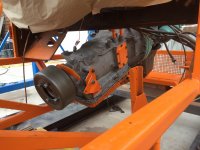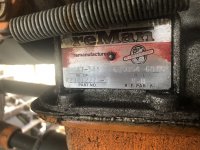Thanks BFT,
I did in the past at your suggestion and did again the other day, try to find John Edward's at Pacific Power Products. They have several divisions/locations but the gal in the main office has told me twice now that they have no John Edward's registered as a company employee. I did get to Brad Robertson, field rep, who was helpful. He looked up my trans by assembly number, and also did some hunting about Allison torque converters.



Brad said my assembly number showed this trans left the factory with a 275 TC (would have been for a diesel). I thought maybe the trans was a rebuilt given how clean it was inside, which could account for a different serial number, but no, numbers match the Tucker door build sticker info. So have to guess Tucker changed the TC to match a gas engine at the original build time. I asked Brad what the actual differences were between the 270 and the 275, thinking the 275 was some sort of upgrade for the gas engine since these two are both 1.96 slip ratio. But again, no. He sent me this;
"Jack,
I had to go all the way back to 1985 to find a document that listed out the differences between the 270 & 275 torque converter.
- The 270 torque converter was originally built for both gasoline & diesel applications but in March 1985 the 270TC was transitioned to gasoline applications only.
- November 1984 the 275TC was introduced to replace the 270TC in all diesel applications.
- The 275TC utilizes brazed pump blades, thicker turbine blades and improved thrust washer material.
- An increased capacity thrust bearing assembly is utilized in both the 270TC & 275TC.
Other than the changes listed above the 270TC & 275TC are identical."
So, what I think I know here.
Allison rates the AT 545 at, max input 4400 rpm, min idle under load 500 rpm, max weight of vehicle 30,000 lbs, max hp 235, and max torque 445 ft/lbs.
I have the 270 TC which is the 1.96 slip ratio. The 275 was a 1.96 slip ratio but was made for a diesel. All other Allison ratio TC were made for diesels. The 275 might be built to better handle additional torque of a diesel, but perhaps not higher rpms, idk. The 1.96 ratio is my best option ratio wise. Weller truck shows availability of only the 290 (1.72 ratio) and the 270. And the 270 only as a rebuilt.
In checking with about half a dozen after market TC suppliers I haven't found any options offered by them, other than rebuilding the one I have.
My thoughts, again.
Weller, who serviced my trans, thinks I have little or nothing to be gained by using a rebuilt TC at this point. Ok. Brad pointed out that my hp is well over what the trans is rated at, and the torque is right at the top end. I'm going with it anyway for a couple reasons other than all the work it would take to accommodate a bigger trans. First, assuming a normal operating range of 2500 to 3500 rpm, the torque stays under the max and hp only slightly over at the upper side of those rpms. Secondly, under my snowcat operating conditions ranging from ice to powder, only a limited amount of torque can be created in the system before ground slippage occurs. Thirdly, I don't generally drive like I'm on a mission from God.
So after delaying putting the engine back in pending this education exercise, I think it's going back together with the 270TC that came out of it.






